Continuing work on Malignanceship - the Cold of Ourey has This year been a Mostly dry Winter (states that use Colorado Rockies Ice Pack are in for Quite a surprise in their upcoming water availability come Springmelt) and has afforded teams to continue their work on the heat shielding installation. Yes - a Lot of Malignanceship is like that - technology that's a little past expiration. In this case, ceramic heat shields for reentry. It's 1980s Space Shuttle technology, but there you have it. It's what a Villain can do on a budget.
But while this work has been going on, One has been tracking the strange signals previously spoken of, and two takes on a New Story has caught my attention. The NRAliens - my enslaved Lizardmen from the Earth's core who Were communicating with something Near Tabby's Star, are saying nothing more than "SSSSlllllaaaar" (translators aside). Which is mostly the only thing they Do say;
What's sending mysterious repeating fast radio bursts in space?
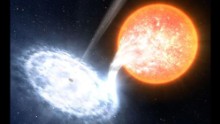
Photos: Wonders of the universe
In March 2016, astronomers published a paper on powerful red flashes coming from binary system V404 Cygni in 2015. This illustration shows a black hole, similar to the one in V404 Cygni, devouring material from an orbiting star.
Hide Caption
31 of 61

Photos: Wonders of the universe
A new map of the Milky Way was released February 24, 2016, giving astronomers a full census of the star-forming regions within our own galaxy. The APEX telescope in Chile captured this survey.
Hide Caption
32 of 61

Photos: Wonders of the universe
This image shows the elliptical galaxy NGC 4889, deeply embedded within the Coma galaxy cluster. There is a gigantic supermassive black hole at the center of the galaxy.
Hide Caption
33 of 61
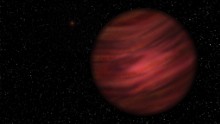
Photos: Wonders of the universe
An artist's impression of 2MASS J2126, which takens 900,000 years to orbit its star, 1 trillion kilometers away.
Hide Caption
34 of 61
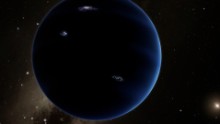
Photos: Wonders of the universe
Caltech researchers have found evidence of a giant planet tracing a bizarre, highly elongated orbit in the outer solar system. The object, nicknamed Planet Nine, has a mass about 10 times that of Earth and orbits about 20 times farther from the sun on average than does Neptune.
Hide Caption
35 of 61

Photos: Wonders of the universe
An international team of astronomers may have discovered the biggest and brightest supernova ever. The explosion was 570 billion times brighter than the sun and 20 times brighter than all the stars in the Milky Way galaxy combined, according to a statement from The Ohio State University, which is leading the study. Scientists are straining to define the supernova's strength. This image shows an artist's impression of the supernova as it would appear from an exoplanet located about 10,000 light years away.
Hide Caption
36 of 61

Photos: Wonders of the universe
Astronomers noticed huge waves of gas being "burped" by the black hole at the center of NGC 5195, a small galaxy 26 million light years from Earth. The team believes the outburst is a consequence of the interaction of NGC 5195 with a nearby galaxy.
Hide Caption
37 of 61
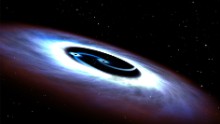
Photos: Wonders of the universe
An artist's illustration shows a binary black hole found in the quasar at the center of the Markarian 231 galaxy. Astronomers using NASA's Hubble Space Telescope discovered the galaxy being powered by two black holes "furiously whirling about each other," the space agency said in a news release.
Hide Caption
38 of 61
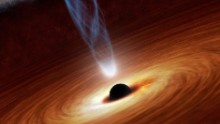
Photos: Wonders of the universe
An artist's impression of what a black hole might look like. In February, researchers in China said they had spotted a super-massive black hole 12 billion times the size of the sun.
Hide Caption
39 of 61

Photos: Wonders of the universe
Are there are oceans on any of Jupiter's moons? The Juice probe shown in this artist's impression aims to find out. Picture courtesy of ESA/AOES
Hide Caption
40 of 61
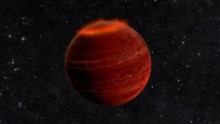
Photos: Wonders of the universe
Astronomers have discovered powerful auroras on a brown dwarf that is 20 light-years away. This is an artist's concept of the phenomenon.
Hide Caption
41 of 61
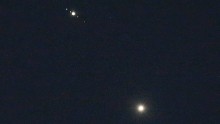
Photos: Wonders of the universe
Venus, bottom, and Jupiter shine brightly above Matthews, North Carolina, on Monday, June 29. The apparent close encounter, called a conjunction, has been giving a dazzling display in the summer sky. Although the two planets appear to be close together, in reality they are millions of miles apart.
Hide Caption
42 of 61
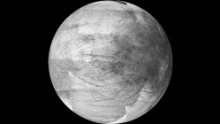
Photos: Wonders of the universe
Jupiter's icy moon Europa may be the best place in the solar system to look for extraterrestrial life, according to NASA. The moon is about the size of Earth's moon, and there is evidence it has an ocean beneath its frozen crust that may hold twice as much water as Earth. NASA's 2016 budget includes a request for $30 million to plan a mission to investigate Europa. The image above was taken by the Galileo spacecraft on November 25, 1999. It's a 12-frame mosaic and is considered the the best image yet of the side of Europa that faces Jupiter.
Hide Caption
43 of 61

Photos: Wonders of the universe
This nebula, or cloud of gas and dust, is called RCW 34 or Gum 19. The brightest areas you can see are where the gas is being heated by young stars. Eventually the gas burst outward like champagne after a bottle is uncorked. Scientists call this champagne flow. This new image of the nebula was captured by the European Space Organization's Very Large Telescope in Chile. RCW 34 is in the constellation Vela in the southern sky. The name means "sails of a ship" in Latin.
Hide Caption
44 of 61
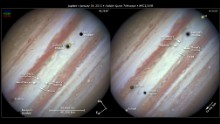
Photos: Wonders of the universe
The Hubble Space Telescope captured images of Jupiter's three great moons -- Io, Callisto, and Europa -- passing by at once.
Hide Caption
45 of 61
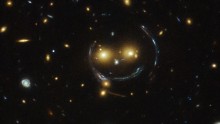
Photos: Wonders of the universe
A massive galaxy cluster known as SDSS J1038+4849 looks like a smiley face in an image captured by the Hubble Telescope. The two glowing eyes are actually two distant galaxies. And what of the smile and the round face? That's a result of what astronomers call "strong gravitational lensing." That happens because the gravitational pull between the two galaxy clusters is so strong it distorts time and space around them.
Hide Caption
46 of 61
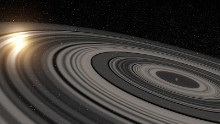
Photos: Wonders of the universe
Using powerful optics, astronomers have found a planet-like body, J1407b, with rings 200 times the size of Saturn's. This is an artist's depiction of the rings of planet J1407b, which are eclipsing a star.
Hide Caption
47 of 61

Photos: Wonders of the universe
A patch of stars appears to be missing in this image from the La Silla Observatory in Chile. But the stars are actually still there behind a cloud of gas and dust called Lynds Dark Nebula 483. The cloud is about 700 light years from Earth in the constellation Serpens (The Serpent).
Hide Caption
48 of 61
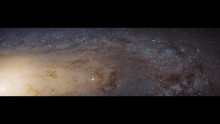
Photos: Wonders of the universe
This is the largest Hubble Space Telescope image ever assembled. It's a portion of the galaxy next door, Andromeda (M31).
Hide Caption
49 of 61

Photos: Wonders of the universe
NASA has captured a stunning new image of the so-called "Pillars of Creation," one of the space agency's most iconic discoveries. The giant columns of cold gas, in a small region of the Eagle Nebula, were popularized by a similar image taken by the Hubble Space Telescope in 1995.
Hide Caption
50 of 61

Photos: Wonders of the universe
Astronomers using the Hubble Space pieced together this picture that shows a small section of space in the southern-hemisphere constellation Fornax. Within this deep-space image are 10,000 galaxies, going back in time as far as a few hundred million years after the Big Bang.
Hide Caption
51 of 61

Photos: Wonders of the universe
Planetary nebula Abell 33 appears ring-like in this image, taken using the European Southern Observatory's Very Large Telescope. The blue bubble was created when an aging star shed its outer layers and a star in the foreground happened to align with it to create a "diamond engagement ring" effect.
Hide Caption
52 of 61
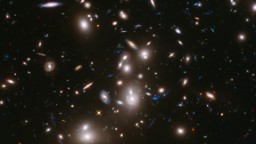
Photos: Wonders of the universe
This long-exposure image from the Hubble Telescope is the deepest-ever picture taken of a cluster of galaxies. The cluster, called Abell 2744, contains several hundred galaxies as they looked 3.5 billion years ago; the more distant galaxies appear as they did more than 12 billion years ago, not long after the Big Bang.
Hide Caption
53 of 61
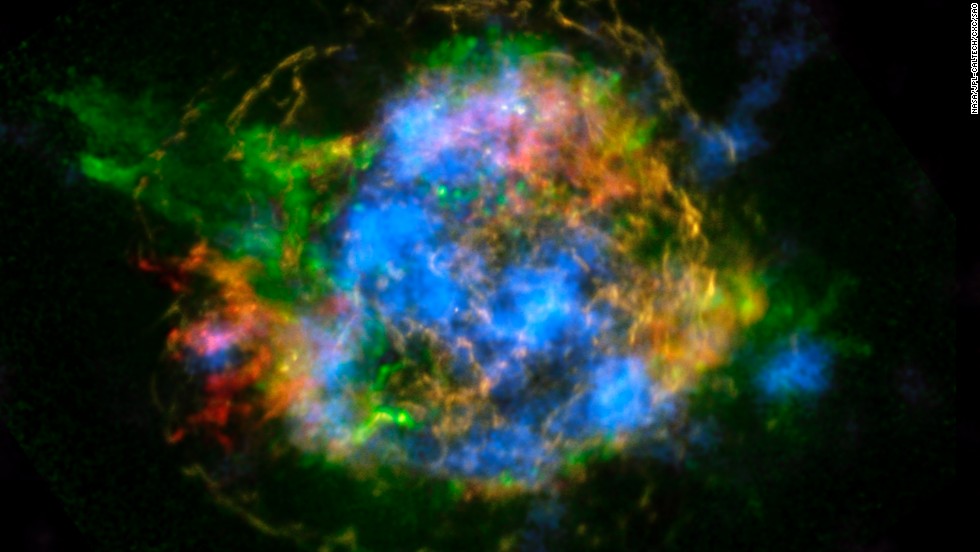
Photos: Wonders of the universe
NASA's NuSTAR telescope array generated the first map of radioactivity in the remnants of an exploding star, or supernova. Blue in this image of Cassiopeia A represents radioactive material.
Hide Caption
54 of 61
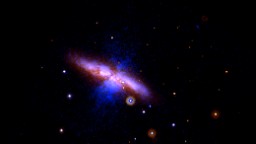
Photos: Wonders of the universe
A supernova was spotted on January 21 in Messier 82, one of the nearest big galaxies. This wide view image was taken on January 22.
Hide Caption
55 of 61
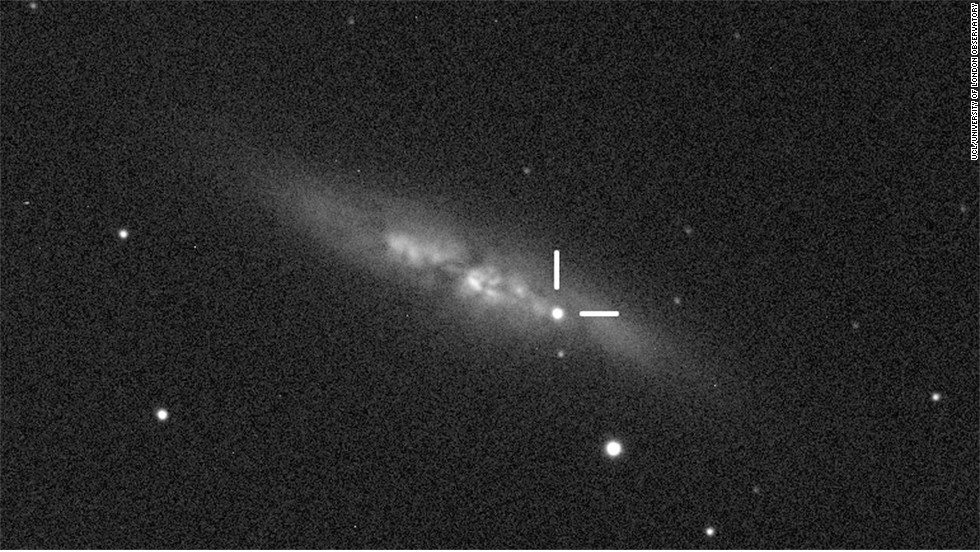
Photos: Wonders of the universe
The M82 supernova, seen here, has been designated SN2014J because it is the 10th supernova detected in 2014. At 11.4 million light years from Earth, it is the closest Type Ia supernova recorded since systematic studies with telescopes began in the 1930s.
Hide Caption
56 of 61
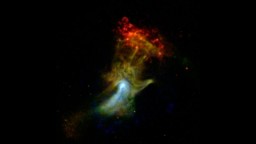
Photos: Wonders of the universe
Is that a giant hand waving at us? Actually, it's what's left of a star that died and exploded a long time ago. Astronomers nicknamed it the "Hand of God." NASA's Nuclear Spectroscopic Telescope Array, or NuSTAR, took this image in high-energy X-rays, shown in blue. The image was combined with images from another space telescope, the Chandra X-ray Observatory.
Hide Caption
57 of 61

Photos: Wonders of the universe
The Hubble Space Telescope captured this image of the Southern Pinwheel Galaxy, one of the largest and closest galaxies of its kind. The center of the galaxy is mysterious, researchers say, because it has a double nucleus -- a supermassive black hole that may be ringed by a lopsided disc of stars, giving it the appearance of a dual core.
Hide Caption
58 of 61

Photos: Wonders of the universe
Hubble scientists say this is the best-ever view of the Tarantula Nebula, which is located in one of our closest galactic neighbors, the Large Magellanic Cloud.
Hide Caption
59 of 61

Photos: Wonders of the universe
Those spots on our sun appear small, but even a moderate-sized spot is about as big as Earth. They occur when strong magnetic fields poke through the sun's surface and let the area cool in comparison to the surrounding area.
Hide Caption
60 of 61

Photos: Wonders of the universe
This Hubble image looks a floating marble or a maybe a giant, disembodied eye. But it's actually a nebula with a giant star at its center. Scientists think the star used to be 20 times more massive than our sun, but it's dying and is destined to go supernova.
Hide Caption
61 of 61

Photos: Wonders of the universe
The Rosette Nebula is 5,000 light-years from Earth. The distinctive nebula, which some claim looks more like a skull, has a hole in the middle that creates the illusion of its rose-like shape.
Hide Caption
1 of 61
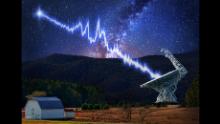
Photos: Wonders of the universe
An illustration depicts the detection of a repeating fast radio burst from a mysterious source 3 billion light-years from Earth.
Hide Caption
2 of 61
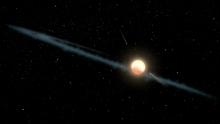
Photos: Wonders of the universe
KIC 8462852, also known as Boyajian's Star or Tabby's Star, is 1,000 light-years from us. It's 50% bigger than our sun and 1,000 degrees hotter. And it doesn't behave like any other star, dimming and brightening sporadically. Dust around the star, depicted here in an artist's illustration, may be the most likely cause of its strange behavior.
Hide Caption
3 of 61

Photos: Wonders of the universe
This inner slope of a Martian crater has several of the seasonal dark streaks called "recurrent slope lineae," or RSL, that a November 2017 report interprets as granular flows, rather than darkening due to flowing water. The image is from the HiRISE camera on NASA's Mars Reconnaissance Orbiter.
Hide Caption
4 of 61
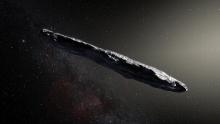
Photos: Wonders of the universe
'Oumuamua, the first observed interstellar asteroid, is shown in an artist's illustration. It is longer and varies more in brightness than any asteroid to be formed in our solar system.
Hide Caption
5 of 61

Photos: Wonders of the universe
This artist's impression shows a supernova explosion, which contains the luminosity of 100 million suns. Supernova iPTF14hls, which has exploded multiple times, may be the most massive and longest-lasting ever observed.
Hide Caption
6 of 61
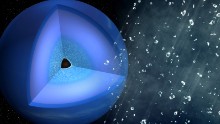
Photos: Wonders of the universe
This illustration shows hydrocarbon compounds splitting into carbon and hydrogen inside ice giants, such as Neptune, turning into a "diamond (rain) shower."
Hide Caption
7 of 61
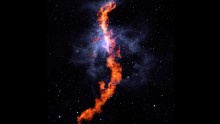
Photos: Wonders of the universe
This striking image is the stellar nursery in the Orion Nebula, where stars are born. The red filament is a stretch of ammonia molecules measuring 50 light-years long. The blue represents the gas of the Orion Nebula. This image is a composite of observation from the Robert C. Byrd Green Bank Telescope and NASA's Wide-field Infrared Survey Explore telescope. "We still don't understand in detail how large clouds of gas in our Galaxy collapse to form new stars," said Rachel Friesen, one of the collaboration's co-Principal Investigators. "But ammonia is an excellent tracer of dense, star-forming gas."
Hide Caption
8 of 61
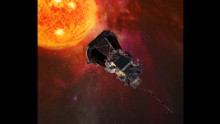
Photos: Wonders of the universe
This is an illustration of the Parker Solar Probe spacecraft approaching the sun. The NASA probe will explore the sun's atmosphere in a mission that begins in the summer of 2018.
Hide Caption
9 of 61

Photos: Wonders of the universe
See that tiny dot between Saturn's rings? That's Earth, as seen by the Cassini mission on April 12, 2017. "Cassini was 870 million miles away from Earth when the image was taken," according to NASA. "Although far too small to be visible in the image, the part of Earth facing Cassini at the time was the southern Atlantic Ocean." Much like the famous "pale blue dot" image captured by Voyager 1 in 1990, we are but a point of light when viewed from the furthest planet in the solar system.
Hide Caption
10 of 61
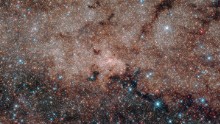
Photos: Wonders of the universe
NASA's Hubble Space Telescope, using infrared technology, reveals the density of stars in the Milky Way.According to NASA, the photo -- stitched together from nine images -- contains more than a half-million stars. The star cluster is the densest in the galaxy.
Hide Caption
11 of 61
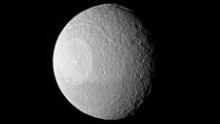
Photos: Wonders of the universe
This photo of Saturn's large icy moon, Tethys, was taken by NASA's Cassini spacecraft, which sent back some jaw-dropping images from the ringed planet.
Hide Caption
12 of 61

Photos: Wonders of the universe
This is what Earth and its moon look like from Mars. The image is a composite of the best Earth image and the best moon image taken on November 20, 2016, by NASA's Mars Reconnaissance Orbiter. The orbiter's camera takes images in three wavelength bands: infrared, red and blue-green. Mars was about 127 million miles from Earth when the images were taken.
Hide Caption
13 of 61
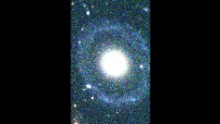
Photos: Wonders of the universe
PGC 1000714 was initially thought to be a common elliptical galaxy, but a closer analysis revealed the incredibly rare discovery of a Hoag-type galaxy. It has a round core encircled by two detached rings.
Hide Caption
14 of 61
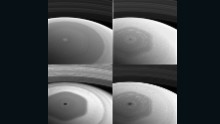
Photos: Wonders of the universe
NASA's Cassini spacecraft took these images of the planet's mysterious hexagon-shaped jetstream in December 2016. The hexagon was discovered in images taken by the Voyager spacecraft in the early 1980s. It's estimated to have a diameter wider than two Earths.
Hide Caption
15 of 61
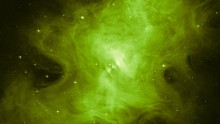
Photos: Wonders of the universe
A dead star gives off a greenish glow in this Hubble Space Telescope image of the Crab Nebula, located about 6,500 light years from Earth in the constellation Taurus. NASA released the image for Halloween 2016 and played up the theme in its press release. The agency said the "ghoulish-looking object still has a pulse." At the center of the Crab Nebula is the crushed core, or "heart" of an exploded star. The heart is spinning 30 times per second and producing a magnetic field that generates 1 trillion volts, NASA said.
Hide Caption
16 of 61
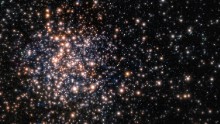
Photos: Wonders of the universe
Peering through the thick dust clouds of the galactic bulge, an international team of astronomers revealed the unusual mix of stars in the stellar cluster known as Terzan 5. The new results indicate that Terzan 5 is one of the bulge's primordial building blocks, most likely the relic of the very early days of the Milky Way.
Hide Caption
17 of 61
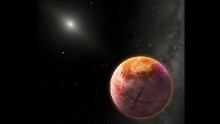
Photos: Wonders of the universe
An artist's conception of Planet Nine, which would be the farthest planet within our solar system. The similar cluster orbits of extreme objects on the edge of our solar system suggest a massive planet is located there.
Hide Caption
18 of 61
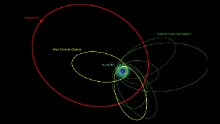
Photos: Wonders of the universe
An illustration of the orbits of the new and previously known extremely distant Solar System objects. The clustering of most of their orbits indicates that they are likely be influenced by something massive and very distant, the proposed Planet X.
Hide Caption
19 of 61
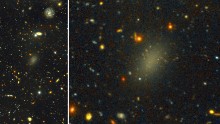
Photos: Wonders of the universe
Say hello to dark galaxy Dragonfly 44. Like our Milky Way, it has a halo of spherical clusters of stars around its core.
Hide Caption
20 of 61
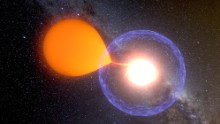
Photos: Wonders of the universe
A classical nova occurs when a white dwarf star gains matter from its secondary star (a red dwarf) over a period of time, causing a thermonuclear reaction on the surface that eventually erupts in a single visible outburst. This creates a 10,000-fold increase in brightness, depicted here in an artist's rendering.
Hide Caption
21 of 61

Photos: Wonders of the universe
Gravitational lensing and space warping are visible in this image of near and distant galaxies captured by Hubble.
Hide Caption
22 of 61
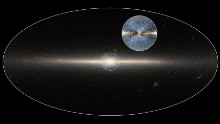
Photos: Wonders of the universe
At the center of our galaxy, the Milky Way, researchers discovered an X-shaped structure within a tightly packed group of stars.
Hide Caption
23 of 61
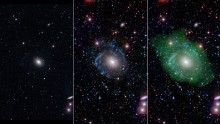
Photos: Wonders of the universe
Meet UGC 1382: What astronomers thought was a normal elliptical galaxy (left) was actually revealed to be a massive disc galaxy made up of different parts when viewed with ultraviolet and deep optical data (center and right). In a complete reversal of normal galaxy structure, the center is younger than its outer spiral disk.
Hide Caption
24 of 61

Photos: Wonders of the universe
NASA's Hubble Space Telescope captured this image of the Crab Nebula and its "beating heart," which is a neutron star at the right of the two bright stars in the center of this image. The neutron star pulses 30 times a second. The rainbow colors are visible due to the movement of materials in the nebula occurring during the time-lapse of the image.
Hide Caption
25 of 61

Photos: Wonders of the universe
The Hubble Space Telescope captured an image of a hidden galaxy that is fainter than Andromeda or the Milky Way. This low surface brightness galaxy, called UGC 477, is over 110 million light-years away in the constellation of Pisces.
Hide Caption
26 of 61
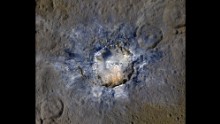
Photos: Wonders of the universe
On April 19, NASA released new images of bright craters on Ceres. This photo shows the Haulani Crater, which has evidence of landslides from its rim. Scientists believe some craters on the dwarf planet are bright because they are relatively new.
Hide Caption
27 of 61

Photos: Wonders of the universe
This illustration shows the millions of dust grains NASA's Cassini spacecraft has sampled near Saturn. A few dozen of them appear to have come from beyond our solar system.
Hide Caption
28 of 61
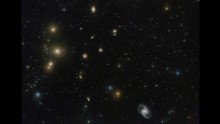
Photos: Wonders of the universe
This image from the VLT Survey Telescope at ESO's Paranal Observatory in Chile shows a stunning concentration of galaxies known as the Fornax Cluster, which can be found in the Southern Hemisphere. At the center of this cluster, in the middle of the three bright blobs on the left side of the image, lies a cD galaxy -- a galactic cannibal that has grown in size by consuming smaller galaxies.
Hide Caption
29 of 61
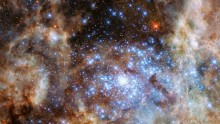
Photos: Wonders of the universe
This image shows the central region of the Tarantula Nebula in the Large Magellanic Cloud. The young and dense star cluster R136, which contains hundreds of massive stars, is visible in the lower right of the image taken by the Hubble Space Telescope.
Hide Caption
30 of 61

Photos: Wonders of the universe
In March 2016, astronomers published a paper on powerful red flashes coming from binary system V404 Cygni in 2015. This illustration shows a black hole, similar to the one in V404 Cygni, devouring material from an orbiting star.
Hide Caption
31 of 61

Photos: Wonders of the universe
A new map of the Milky Way was released February 24, 2016, giving astronomers a full census of the star-forming regions within our own galaxy. The APEX telescope in Chile captured this survey.
Hide Caption
32 of 61

Photos: Wonders of the universe
This image shows the elliptical galaxy NGC 4889, deeply embedded within the Coma galaxy cluster. There is a gigantic supermassive black hole at the center of the galaxy.
Hide Caption
33 of 61

Photos: Wonders of the universe
An artist's impression of 2MASS J2126, which takens 900,000 years to orbit its star, 1 trillion kilometers away.
Hide Caption
34 of 61

Photos: Wonders of the universe
Caltech researchers have found evidence of a giant planet tracing a bizarre, highly elongated orbit in the outer solar system. The object, nicknamed Planet Nine, has a mass about 10 times that of Earth and orbits about 20 times farther from the sun on average than does Neptune.
Hide Caption
35 of 61

Photos: Wonders of the universe
An international team of astronomers may have discovered the biggest and brightest supernova ever. The explosion was 570 billion times brighter than the sun and 20 times brighter than all the stars in the Milky Way galaxy combined, according to a statement from The Ohio State University, which is leading the study. Scientists are straining to define the supernova's strength. This image shows an artist's impression of the supernova as it would appear from an exoplanet located about 10,000 light years away.
Hide Caption
36 of 61

Photos: Wonders of the universe
Astronomers noticed huge waves of gas being "burped" by the black hole at the center of NGC 5195, a small galaxy 26 million light years from Earth. The team believes the outburst is a consequence of the interaction of NGC 5195 with a nearby galaxy.
Hide Caption
37 of 61

Photos: Wonders of the universe
An artist's illustration shows a binary black hole found in the quasar at the center of the Markarian 231 galaxy. Astronomers using NASA's Hubble Space Telescope discovered the galaxy being powered by two black holes "furiously whirling about each other," the space agency said in a news release.
Hide Caption
38 of 61

Photos: Wonders of the universe
An artist's impression of what a black hole might look like. In February, researchers in China said they had spotted a super-massive black hole 12 billion times the size of the sun.
Hide Caption
39 of 61

Photos: Wonders of the universe
Are there are oceans on any of Jupiter's moons? The Juice probe shown in this artist's impression aims to find out. Picture courtesy of ESA/AOES
Hide Caption
40 of 61

Photos: Wonders of the universe
Astronomers have discovered powerful auroras on a brown dwarf that is 20 light-years away. This is an artist's concept of the phenomenon.
Hide Caption
41 of 61

Photos: Wonders of the universe
Venus, bottom, and Jupiter shine brightly above Matthews, North Carolina, on Monday, June 29. The apparent close encounter, called a conjunction, has been giving a dazzling display in the summer sky. Although the two planets appear to be close together, in reality they are millions of miles apart.
Hide Caption
42 of 61

Photos: Wonders of the universe
Jupiter's icy moon Europa may be the best place in the solar system to look for extraterrestrial life, according to NASA. The moon is about the size of Earth's moon, and there is evidence it has an ocean beneath its frozen crust that may hold twice as much water as Earth. NASA's 2016 budget includes a request for $30 million to plan a mission to investigate Europa. The image above was taken by the Galileo spacecraft on November 25, 1999. It's a 12-frame mosaic and is considered the the best image yet of the side of Europa that faces Jupiter.
Hide Caption
43 of 61

Photos: Wonders of the universe
This nebula, or cloud of gas and dust, is called RCW 34 or Gum 19. The brightest areas you can see are where the gas is being heated by young stars. Eventually the gas burst outward like champagne after a bottle is uncorked. Scientists call this champagne flow. This new image of the nebula was captured by the European Space Organization's Very Large Telescope in Chile. RCW 34 is in the constellation Vela in the southern sky. The name means "sails of a ship" in Latin.
Hide Caption
44 of 61

Photos: Wonders of the universe
The Hubble Space Telescope captured images of Jupiter's three great moons -- Io, Callisto, and Europa -- passing by at once.
Hide Caption
45 of 61

Photos: Wonders of the universe
A massive galaxy cluster known as SDSS J1038+4849 looks like a smiley face in an image captured by the Hubble Telescope. The two glowing eyes are actually two distant galaxies. And what of the smile and the round face? That's a result of what astronomers call "strong gravitational lensing." That happens because the gravitational pull between the two galaxy clusters is so strong it distorts time and space around them.
Hide Caption
46 of 61

Photos: Wonders of the universe
Using powerful optics, astronomers have found a planet-like body, J1407b, with rings 200 times the size of Saturn's. This is an artist's depiction of the rings of planet J1407b, which are eclipsing a star.
Hide Caption
47 of 61

Photos: Wonders of the universe
A patch of stars appears to be missing in this image from the La Silla Observatory in Chile. But the stars are actually still there behind a cloud of gas and dust called Lynds Dark Nebula 483. The cloud is about 700 light years from Earth in the constellation Serpens (The Serpent).
Hide Caption
48 of 61

Photos: Wonders of the universe
This is the largest Hubble Space Telescope image ever assembled. It's a portion of the galaxy next door, Andromeda (M31).
Hide Caption
49 of 61

Photos: Wonders of the universe
NASA has captured a stunning new image of the so-called "Pillars of Creation," one of the space agency's most iconic discoveries. The giant columns of cold gas, in a small region of the Eagle Nebula, were popularized by a similar image taken by the Hubble Space Telescope in 1995.
Hide Caption
50 of 61

Photos: Wonders of the universe
Astronomers using the Hubble Space pieced together this picture that shows a small section of space in the southern-hemisphere constellation Fornax. Within this deep-space image are 10,000 galaxies, going back in time as far as a few hundred million years after the Big Bang.
Hide Caption
51 of 61

Photos: Wonders of the universe
Planetary nebula Abell 33 appears ring-like in this image, taken using the European Southern Observatory's Very Large Telescope. The blue bubble was created when an aging star shed its outer layers and a star in the foreground happened to align with it to create a "diamond engagement ring" effect.
Hide Caption
52 of 61

Photos: Wonders of the universe
This long-exposure image from the Hubble Telescope is the deepest-ever picture taken of a cluster of galaxies. The cluster, called Abell 2744, contains several hundred galaxies as they looked 3.5 billion years ago; the more distant galaxies appear as they did more than 12 billion years ago, not long after the Big Bang.
Hide Caption
53 of 61

Photos: Wonders of the universe
NASA's NuSTAR telescope array generated the first map of radioactivity in the remnants of an exploding star, or supernova. Blue in this image of Cassiopeia A represents radioactive material.
Hide Caption
54 of 61

Photos: Wonders of the universe
A supernova was spotted on January 21 in Messier 82, one of the nearest big galaxies. This wide view image was taken on January 22.
Hide Caption
55 of 61

Photos: Wonders of the universe
The M82 supernova, seen here, has been designated SN2014J because it is the 10th supernova detected in 2014. At 11.4 million light years from Earth, it is the closest Type Ia supernova recorded since systematic studies with telescopes began in the 1930s.
Hide Caption
56 of 61

Photos: Wonders of the universe
Is that a giant hand waving at us? Actually, it's what's left of a star that died and exploded a long time ago. Astronomers nicknamed it the "Hand of God." NASA's Nuclear Spectroscopic Telescope Array, or NuSTAR, took this image in high-energy X-rays, shown in blue. The image was combined with images from another space telescope, the Chandra X-ray Observatory.
Hide Caption
57 of 61

Photos: Wonders of the universe
The Hubble Space Telescope captured this image of the Southern Pinwheel Galaxy, one of the largest and closest galaxies of its kind. The center of the galaxy is mysterious, researchers say, because it has a double nucleus -- a supermassive black hole that may be ringed by a lopsided disc of stars, giving it the appearance of a dual core.
Hide Caption
58 of 61

Photos: Wonders of the universe
Hubble scientists say this is the best-ever view of the Tarantula Nebula, which is located in one of our closest galactic neighbors, the Large Magellanic Cloud.
Hide Caption
59 of 61

Photos: Wonders of the universe
Those spots on our sun appear small, but even a moderate-sized spot is about as big as Earth. They occur when strong magnetic fields poke through the sun's surface and let the area cool in comparison to the surrounding area.
Hide Caption
60 of 61

Photos: Wonders of the universe
This Hubble image looks a floating marble or a maybe a giant, disembodied eye. But it's actually a nebula with a giant star at its center. Scientists think the star used to be 20 times more massive than our sun, but it's dying and is destined to go supernova.
Hide Caption
61 of 61

Photos: Wonders of the universe
The Rosette Nebula is 5,000 light-years from Earth. The distinctive nebula, which some claim looks more like a skull, has a hole in the middle that creates the illusion of its rose-like shape.
Hide Caption
1 of 61

Photos: Wonders of the universe
An illustration depicts the detection of a repeating fast radio burst from a mysterious source 3 billion light-years from Earth.
Hide Caption
2 of 61

Photos: Wonders of the universe
KIC 8462852, also known as Boyajian's Star or Tabby's Star, is 1,000 light-years from us. It's 50% bigger than our sun and 1,000 degrees hotter. And it doesn't behave like any other star, dimming and brightening sporadically. Dust around the star, depicted here in an artist's illustration, may be the most likely cause of its strange behavior.
Hide Caption
3 of 61

Photos: Wonders of the universe
This inner slope of a Martian crater has several of the seasonal dark streaks called "recurrent slope lineae," or RSL, that a November 2017 report interprets as granular flows, rather than darkening due to flowing water. The image is from the HiRISE camera on NASA's Mars Reconnaissance Orbiter.
Hide Caption
4 of 61

Photos: Wonders of the universe
'Oumuamua, the first observed interstellar asteroid, is shown in an artist's illustration. It is longer and varies more in brightness than any asteroid to be formed in our solar system.
Hide Caption
5 of 61

Photos: Wonders of the universe
This artist's impression shows a supernova explosion, which contains the luminosity of 100 million suns. Supernova iPTF14hls, which has exploded multiple times, may be the most massive and longest-lasting ever observed.
Hide Caption
6 of 61

Photos: Wonders of the universe
This illustration shows hydrocarbon compounds splitting into carbon and hydrogen inside ice giants, such as Neptune, turning into a "diamond (rain) shower."
Hide Caption
7 of 61

Photos: Wonders of the universe
This striking image is the stellar nursery in the Orion Nebula, where stars are born. The red filament is a stretch of ammonia molecules measuring 50 light-years long. The blue represents the gas of the Orion Nebula. This image is a composite of observation from the Robert C. Byrd Green Bank Telescope and NASA's Wide-field Infrared Survey Explore telescope. "We still don't understand in detail how large clouds of gas in our Galaxy collapse to form new stars," said Rachel Friesen, one of the collaboration's co-Principal Investigators. "But ammonia is an excellent tracer of dense, star-forming gas."
Hide Caption
8 of 61

Photos: Wonders of the universe
This is an illustration of the Parker Solar Probe spacecraft approaching the sun. The NASA probe will explore the sun's atmosphere in a mission that begins in the summer of 2018.
Hide Caption
9 of 61

Photos: Wonders of the universe
See that tiny dot between Saturn's rings? That's Earth, as seen by the Cassini mission on April 12, 2017. "Cassini was 870 million miles away from Earth when the image was taken," according to NASA. "Although far too small to be visible in the image, the part of Earth facing Cassini at the time was the southern Atlantic Ocean." Much like the famous "pale blue dot" image captured by Voyager 1 in 1990, we are but a point of light when viewed from the furthest planet in the solar system.
Hide Caption
10 of 61

Photos: Wonders of the universe
NASA's Hubble Space Telescope, using infrared technology, reveals the density of stars in the Milky Way.According to NASA, the photo -- stitched together from nine images -- contains more than a half-million stars. The star cluster is the densest in the galaxy.
Hide Caption
11 of 61

Photos: Wonders of the universe
This photo of Saturn's large icy moon, Tethys, was taken by NASA's Cassini spacecraft, which sent back some jaw-dropping images from the ringed planet.
Hide Caption
12 of 61

Photos: Wonders of the universe
This is what Earth and its moon look like from Mars. The image is a composite of the best Earth image and the best moon image taken on November 20, 2016, by NASA's Mars Reconnaissance Orbiter. The orbiter's camera takes images in three wavelength bands: infrared, red and blue-green. Mars was about 127 million miles from Earth when the images were taken.
Hide Caption
13 of 61

Photos: Wonders of the universe
PGC 1000714 was initially thought to be a common elliptical galaxy, but a closer analysis revealed the incredibly rare discovery of a Hoag-type galaxy. It has a round core encircled by two detached rings.
Hide Caption
14 of 61

Photos: Wonders of the universe
NASA's Cassini spacecraft took these images of the planet's mysterious hexagon-shaped jetstream in December 2016. The hexagon was discovered in images taken by the Voyager spacecraft in the early 1980s. It's estimated to have a diameter wider than two Earths.
Hide Caption
15 of 61

Photos: Wonders of the universe
A dead star gives off a greenish glow in this Hubble Space Telescope image of the Crab Nebula, located about 6,500 light years from Earth in the constellation Taurus. NASA released the image for Halloween 2016 and played up the theme in its press release. The agency said the "ghoulish-looking object still has a pulse." At the center of the Crab Nebula is the crushed core, or "heart" of an exploded star. The heart is spinning 30 times per second and producing a magnetic field that generates 1 trillion volts, NASA said.
Hide Caption
16 of 61

Photos: Wonders of the universe
Peering through the thick dust clouds of the galactic bulge, an international team of astronomers revealed the unusual mix of stars in the stellar cluster known as Terzan 5. The new results indicate that Terzan 5 is one of the bulge's primordial building blocks, most likely the relic of the very early days of the Milky Way.
Hide Caption
17 of 61

Photos: Wonders of the universe
An artist's conception of Planet Nine, which would be the farthest planet within our solar system. The similar cluster orbits of extreme objects on the edge of our solar system suggest a massive planet is located there.
Hide Caption
18 of 61

Photos: Wonders of the universe
An illustration of the orbits of the new and previously known extremely distant Solar System objects. The clustering of most of their orbits indicates that they are likely be influenced by something massive and very distant, the proposed Planet X.
Hide Caption
19 of 61

Photos: Wonders of the universe
Say hello to dark galaxy Dragonfly 44. Like our Milky Way, it has a halo of spherical clusters of stars around its core.
Hide Caption
20 of 61

Photos: Wonders of the universe
A classical nova occurs when a white dwarf star gains matter from its secondary star (a red dwarf) over a period of time, causing a thermonuclear reaction on the surface that eventually erupts in a single visible outburst. This creates a 10,000-fold increase in brightness, depicted here in an artist's rendering.
Hide Caption
21 of 61

Photos: Wonders of the universe
Gravitational lensing and space warping are visible in this image of near and distant galaxies captured by Hubble.
Hide Caption
22 of 61

Photos: Wonders of the universe
At the center of our galaxy, the Milky Way, researchers discovered an X-shaped structure within a tightly packed group of stars.
Hide Caption
23 of 61

Photos: Wonders of the universe
Meet UGC 1382: What astronomers thought was a normal elliptical galaxy (left) was actually revealed to be a massive disc galaxy made up of different parts when viewed with ultraviolet and deep optical data (center and right). In a complete reversal of normal galaxy structure, the center is younger than its outer spiral disk.
Hide Caption
24 of 61

Photos: Wonders of the universe
NASA's Hubble Space Telescope captured this image of the Crab Nebula and its "beating heart," which is a neutron star at the right of the two bright stars in the center of this image. The neutron star pulses 30 times a second. The rainbow colors are visible due to the movement of materials in the nebula occurring during the time-lapse of the image.
Hide Caption
25 of 61

Photos: Wonders of the universe
The Hubble Space Telescope captured an image of a hidden galaxy that is fainter than Andromeda or the Milky Way. This low surface brightness galaxy, called UGC 477, is over 110 million light-years away in the constellation of Pisces.
Hide Caption
26 of 61

Photos: Wonders of the universe
On April 19, NASA released new images of bright craters on Ceres. This photo shows the Haulani Crater, which has evidence of landslides from its rim. Scientists believe some craters on the dwarf planet are bright because they are relatively new.
Hide Caption
27 of 61

Photos: Wonders of the universe
This illustration shows the millions of dust grains NASA's Cassini spacecraft has sampled near Saturn. A few dozen of them appear to have come from beyond our solar system.
Hide Caption
28 of 61

Photos: Wonders of the universe
This image from the VLT Survey Telescope at ESO's Paranal Observatory in Chile shows a stunning concentration of galaxies known as the Fornax Cluster, which can be found in the Southern Hemisphere. At the center of this cluster, in the middle of the three bright blobs on the left side of the image, lies a cD galaxy -- a galactic cannibal that has grown in size by consuming smaller galaxies.
Hide Caption
29 of 61

Photos: Wonders of the universe
This image shows the central region of the Tarantula Nebula in the Large Magellanic Cloud. The young and dense star cluster R136, which contains hundreds of massive stars, is visible in the lower right of the image taken by the Hubble Space Telescope.
Hide Caption
30 of 61

Photos: Wonders of the universe
In March 2016, astronomers published a paper on powerful red flashes coming from binary system V404 Cygni in 2015. This illustration shows a black hole, similar to the one in V404 Cygni, devouring material from an orbiting star.
Hide Caption
31 of 61


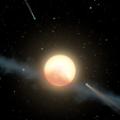

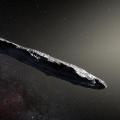
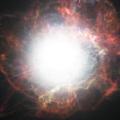
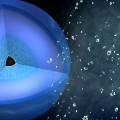



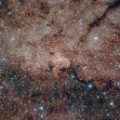
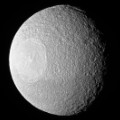

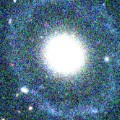
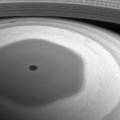
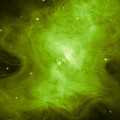




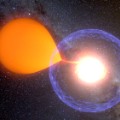

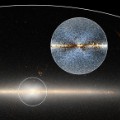

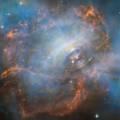
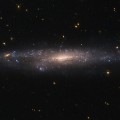

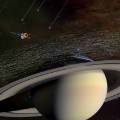
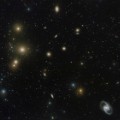

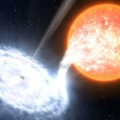
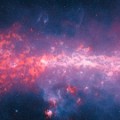
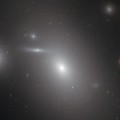

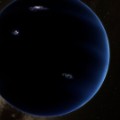
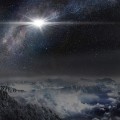
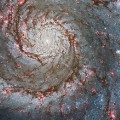
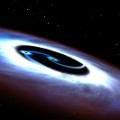
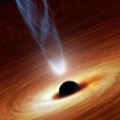


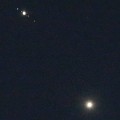
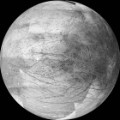

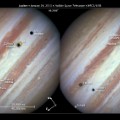
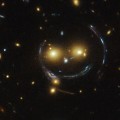
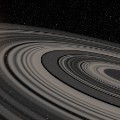
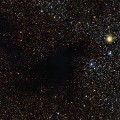
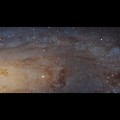
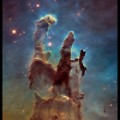







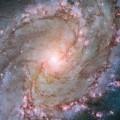
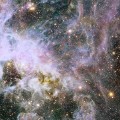


Story highlights
- A repeating fast radio burst 3 billion light-years from Earth may be coming from a neutron star
- The strong magnetic field around it could be the result of a black hole or powerful nebula
(CNN)The only known repeating fast radio burst in the universe just got more extreme.
These radio flashes usually last a millisecond and have an unknown physical origin. People love to believe that they're from an advanced extraterrestrial civilization, and this hypothesis hasn't been ruled out entirely by researchers at Breakthrough Listen, a scientific research program dedicated to finding evidence of intelligent life in the universe.
Fast radio bursts in space themselves are not rare, but FRB 121102 -- first detected in 2012 -- is the only one that has been known to repeat. And the repetition is sporadic.
Last year, its host galaxy, a star-forming dwarf galaxy 3 billion light-years from Earth, was also identified.
Now, researchers have used the newest detections to learn more about the extreme environment for the source of this mysterious burst. The details were revealed in a study published in the journal Nature as well as at this week's 231st meeting of the American Astronomical Society in Washington.
The radio burst itself releases a "monstrous" amount of energy in each millisecond, comparable to what our sun releases in an entire day, the researchers said.
The newest detections allowed researchers to discover that the radio bursts themselves are polarized and coming from an environment that contains an incredibly strong magnetic field. They were also able to detect the radio bursts at a higher frequency than ever.
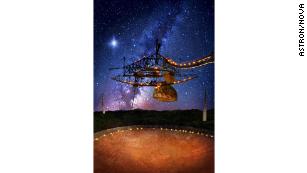
Data from the Arecibo Observatory in Puerto Rico helped with new research about fast radio bursts.
When the radio waves pass through the magnetic field, they are twisted in a way known as Faraday rotation. The stronger the magnetic field, the greater the twist. The degree of twist for the latest detections of FRB is among the largest ever measured in a radio source.
"FRB 121102 was already unique because it repeats; now, the huge Faraday rotation we have observed singles it out yet again. We're curious as to whether these two unique aspects are linked," said Daniele Michilli, a Ph.D. candidate at the University of Amsterdam and ASTRON, the Netherlands Institute for Radio Astronomy.
The causes of such a strong magnetic field provide two intriguing possibilities: proximity to a massive black hole in the galaxy or within a powerful nebula.
These hypotheses both support some factors of the radio bursts but also raise questions.
Jason Hessels, study author and associate professor at the University of Amsterdam and ASTRON, described the possibilities.
If it's near a massive black hole, that would explain the persistent radio source and create the right kind of environment, but the researchers aren't entirely confident that such a massive black hole would exist in a dwarf galaxy.
If it's within a powerful nebula, an interstellar cloud of gas or dust, it would also explain the persistent radio source and remain consistent with the fact that astronomers believe the source of the bursts is "young." But it's a million times brighter than the Crab nebula in our own galaxy, which is already massively bright. How could the nebula be that bright?
As for the direct source itself, the latest findings support the idea that it's a neutron star or a pulsar, a highly magnetized and rotating neutron star.
The fact that the source throws out short bursts, ranging from 30 microseconds to 9 milliseconds, supports a source that is just over 6 miles across. That's the right size for a neutron star.

A 3-D-printed version of the variation in fast radio bursts.
Or it could be something undiscovered.
"We can not rule out completely the ET hypothesis for the FRBs in general," said University of California, Berkeley, postdoctoral fellow Vishal Gajjar of Breakthrough Listen and the Berkeley SETI Research Center.
The researchers are eager to use a number of observatories with new radio telescopes coming online to observe more fast radio bursts. They estimate that there are 10,000 fast radio bursts happening per day in each area of the sky that telescopes around the world are able to monitor. That's a radio flash every 10 seconds, and radio telescopes will be able to find them.
They hope to learn whether the bursts have their own periodicity, or intervals at which they recur, as well as discovering the true nature of the persistent radio source.
"We are continuing to monitor how the properties of the bursts change with time," Hessels said. "With these observations, we hope to distinguish between the two competing hypotheses of a neutron star either near a black hole or embedded in a powerful nebula."
Source; CNN
And;
Mysterious Intergalactic Radio Bursts Come From a Truly Alien Environment
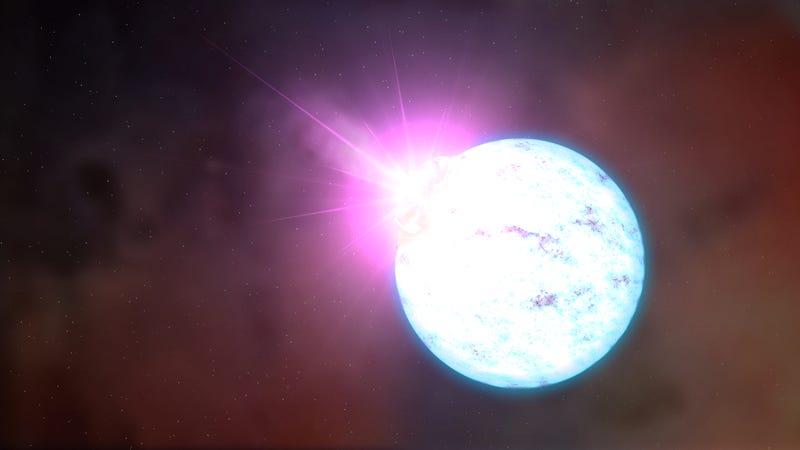
First detected in 2002, Fast Radio Bursts (FRBs) are quick, high-energy pulses originating from galaxies billions of light years away. Scientists still don’t know the true nature of these bursts or what’s causing them, but new observations of the only known repeating FRBs are providing details about the extreme environments in which these pulses are born.
To date, astronomers have only documented a handful of FRBs; their fleeting, unpredictable appearances make observations difficult. A few years ago, however, scientists detected the only known source of repeating FRBs, an object dubbed FRB 121102. A new paper published today in Nature is now the first to provide a description of the environment in which this source is located. We still don’t know the nature of the source or cause of this repeating FRB, but the detection of an immensely powerful magnetic field in its vicinity suggests some tantalizing possibilities.
Using the Arecibo Telescope in Puerto Rico and the Green Bank Telescope in West Virginia, an international team of astronomers led by Jason Hessels from the University of Amsterdam detected and monitored 16 recent bursts from FRB 1211012, which is located three billion light years from Earth in a nebula (a star-forming region) within a dwarf galaxy.
That’s an extreme distance, to say the least. Whatever’s causing these bursts must be releasing enormous amounts of energy with each pulse. Scientists estimate that there’s as much energy packed into a single millisecond of an FRB as our Sun releases over an entire day. Theories as to what’s causing FRBs include everything from magnetized neutron stars and supernovae through to supermassive black holes and the activities of extraterrestrial civilizations (yes, really).
What these researchers found was that these bursts are highly polarized, exhibiting a very high and variable Faraday rotation measure. When polarized waves travel through an area with a magnetic field, the polarization gets twisted by a phenomenon known as Faraday rotation. The stronger the magnetic field, the stronger the twisting. In the case of FRB 1211012, the twists are among the largest ever recorded in a radio source. This led the researchers to conclude that the pulses must be passing through an incredibly strong magnetic field in a dense plasma.
“This leads us to two hypotheses,” Hessels told Gizmodo, “The source is either a neutron star in an environment like [the one] at the center of our Milky Way galaxy, where there is a very massive black hole, or the source is in a dense, powerful, and highly magnetized nebula.”
Neutron stars are the remnants of ancient stars, between 10 to 29 times the size of our own Sun, that exploded in supernovae, where only the core remains. These stars aren’t capable of producing nuclear fusion reactions, so the absence of outward pressure causes the star to collapse in on itself, forming a small, super-dense orb. Neutron stars are so gravitationally heavy that they cause protons and electrons to combine into neutrons (hence their name).
Emily Petroff, an astronomer from the Netherlands Institute for Radio Astronomy who wasn’t involved with the new study, likes the new paper, telling Gizmodo that “the data and analysis are robust and the result has been confirmed with observations at multiple telescopes—that’s good enough for me.”
As for the possible source of the FRB, Petroff said it’s hard to say which scenario is responsible.
“I will say that putting the FRB source close to a black hole makes most sense based on what we already know in the Universe,” she said. “The black hole at the center of the Milky Way is the only place we’ve seen such strong fields, but just because we don’t have anything else similarly strong in our own galaxy (like a newborn magnetar in a dense nebula) doesn’t mean there can’t be other causes in other galaxies. Ultimately more observations are needed.”
Hessels said it’s possible that the neutron star is a magnetar, but “it’s also possible that it isn’t a magnetar.”
Astronomer Avi Loeb from Harvard-Smithsonian Center for Astrophysics—also not involved with the new study—said the repetitive nature of FRB 121102 means it can’t be associated with a cataclysmic event, such as an explosion, a merger of compact objects, or the collapse of a star, as some astronomers have previously suggested. He said the new study, with its “inferred properties of the extreme magnetic environment,” doesn’t pinpoint a single source type, saying it could, for example, be accommodated by a young neutron star or the extreme conditions located at the center of a galaxy, the latter of which he says is unlikely.
“But at this point we do not know much about the nature of the FRB source, so we could only speculate,” Loeb told Gizmodo. “Future observations of this source, or more importantly of other FRBs, will inform us about the nature of this enigmatic bursters. It could be that FRBs originate from a diverse population of sources, each associated with a different origin.”
In a previous paper, along with his postdoc, Anastasia Fialkov, Loeb estimated that, based on current data, there should be an FRB every second in the entire observable universe. “With improved sensitivity of future radio telescopes, such as CHIME or SKA, we should be able to get a better census of FRBs and decipher their origin,” he said.
Petroff said it’s important to keep in mind that this particular FRB is special.
“No other FRBs have been seen to repeat and the jury is still very much out as to whether this FRB is similar to the 30 or so others that have been found,” she told Gizmodo. “While this work gives us unprecedented detail into the workings of this one source, I would still encourage people not to over-generalize. What is true for FRB 121102 may not be true for other FRBs that haven’t been seen to repeat yet. Only time, more observations, and more FRBs will tell!”
Given that we do not understand the origin of FRBs, Loeb says we should keep an open mind and examine future data without a prejudice. He even says we should even entertain the possibility that some FRBs are associated with artificial radio beams produced by alien civilizations.
“This is an exciting frontier,” Loeb told Gizmodo. “It is rare to discover a new population of sources. Whenever we did that in the past, we learned something new about the Universe.”
[Nature]
ABOUT THE AUTHOR

George Dvorsky
George is a contributing editor at Gizmodo and io9.
Source; Gizmodo
Apologies for the formatting nightmare you are no doubt recovering from.-M.

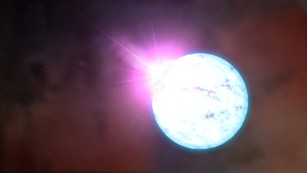
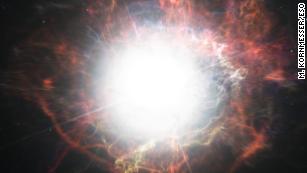
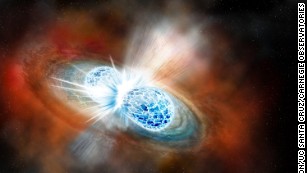
No comments:
Post a Comment